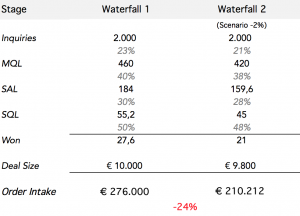Demand planning can be a tough challenge for B2B marketers. A popular approach to setting B2B marketing goals is to ‘reverse the Demand Waterfall’. But this can be misleading. Reason: the coming months and years won’t be the same as the previous months and years.
To explain the risk of reversing the funnel, let’s take Sirius Decision’s ‘Demand Waterfall’ model as an example. The Demand Waterfall is one of the most popular and widely adopted frameworks in B2B marketing. It is a practical tool, helping many marketing and sales leaders to monitor pipeline health. A strong element of the model is that it shows how marketing and sales teams depend on each other for achieving commercial success.

The Demand Waterfall consists of multiple stages, from Inquiry to Close. Marketers can use data from their marketing automation and CRM systems to get insight into how well they perform in each stage of the waterfall. In order to optimize their pipeline, marketing and sales managers should look at four elements:
1. Volume: the number of inquiries, leads, opportunities and deals in the different waterfall stages;
2. Value: the (estimated) value of all opportunities and deals;
3. Velocity: the number of days it takes for a lead to progress from one stage to the next;
4. Conversion rates: the percentage of leads that go from one stage to the next.
Marketers can use benchmark data to see how well they perform compared to their peers. In order to improve business results, marketing and sales managers can then try to influence the four elements using different tactics.
The ‘Reverse Waterfall’
Companies that have their funnel metrics in place, can use this information to set goals for the next time period. A popular approach to do this is to ‘reverse the Demand Waterfall’:
In this approach your starting point is the total target revenue for the next time period. Using waterfall conversion rates and average deal sizes, you then calculate the number of deals to win, the number of qualified leads and the number of inquiries you need to generate in order to achieve your target. Using cost per lead, you can then calculate the budget needed to generate the number of inquiries.
The risk
The risk of reversing the waterfall is that people tend to use the conversion rates to calculate and communicate expected results of future marketing programs. This can be misleading. What if your estimations turn out to be, say, 2% off for each conversion rate in the waterfall? Because of dependencies between waterfall stages, this can easily lead to a 25% difference in the total end result:

How to get a more realistic view
As explained in this presentation, most companies need to create multiple waterfalls because of different waterfall conversion rates for specific products, services, regions etcetera. Doing this will give you a far better picture already. But still, you are using averages from previous months and years, which can be misleading.
Demand waterfall on steroids
If you want to become more accurate, it might be better to use estimated impact of planned marketing programs instead of average waterfall conversion rates. In order to do this, you first need to know which marketing programs you plan to launch. For each program you then map out how they will impact each element of the marketing and sales funnel. The next step is to ask the experts in your organization to estimate the impact of each program on each element in the waterfall.
The estimations should be a range, consisting of a low barrier and a high barrier. The experts need to be ‘almost certain’ that the eventual results will fall in this range. Using simulation techniques, you then calculate the results for each and every possible outcome for all ranges provided. You need to repeat the steps for every program and for each part of the waterfall. Lastly, you can combine the results of all simulations and the result will be a more realistic picture of the estimated overall marketing results. It might sound a bit complex but it’s actually not very hard to make it work.
Example: Lead Generation
In this example (don’t mind the numbers) we take a simple lead generation program, asking marketing and sales to provide the estimations.
First, the marketing manager tells us that he is almost certain that:
• The online paid campaign will reach more than 165k and less than 300k people in the target audience;
• CTR will be between 0.2% and 0.45%;
• Landing page conversion rates will be between 9% and 16%.
The marketer responsible for lead nurturing is almost certain that:
• Between 13% and 21% of all inquiries will become an MQL.
Sales is almost certain that:
• Between 23% and 42% of all MQLs will result in deals won;
• Deal sizes will range from €7.500 to €11.250.
These are all the numbers we need to include in our calculations. The screenshot below contains the simulation results for this program as well as 2 additional example programs.

The benefit of using this approach is that you take uncertainty into account, leaving you with a more realistic picture of the expected outcomes of your marketing plans. Keep in mind that in order to use this method it is important to have a good understanding of how your marketing programs will impact the different elements of the demand waterfall.
Feel free to reach out in case you like to try this approach or if you have a different method that works really well for your organization.







